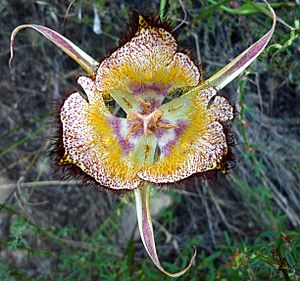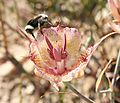Late-blooming mariposa lily facts for kids
Quick facts for kids Late-blooming mariposa lily |
|
|---|---|
 |
|
| Scientific classification | |
| Genus: |
Calochortus
|
| Species: |
fimbriatus
|
| Synonyms | |
|
|
The late-blooming mariposa lily (Calochortus fimbriatus) is a beautiful flowering plant found in California. It belongs to the lily family. This plant is known for blooming later in the year compared to other similar lilies.
You can find it growing naturally in the coastal mountains of southern Monterey, San Luis Obispo, Santa Barbara, and northern Ventura counties. It is a common plant in the chaparral areas, which are special shrublands found in California.
This lily is considered "rare, threatened, or endangered" in California. This means it needs protection to make sure it continues to grow in the wild.
Contents
About the Late-Blooming Mariposa Lily
The late-blooming mariposa lily grows from a bulb, like many other lilies. It is a perennial plant, meaning it lives for more than two years. It comes back to life each year.
It produces a thin, branching stem that can grow from about 30 to 110 centimeters tall. That's like a little over a foot to more than three feet tall!
Leaves and Blooming Time
A long leaf, up to 40 centimeters, grows from the base of the plant in January. This leaf helps the plant gather energy early in the year. However, it dries up long before the flowers appear.
The flowers usually start to bloom in late June or early July. They continue to bloom until the middle of August. This late blooming period gives the lily its common name.
Flower Appearance
Each plant can have 2 to 6 flowers that stand upright. The flowers are shaped like bowls. Each flower has three narrow sepals and three wider petals.
The petals are often tan or cream-colored on the outside. Inside, they are usually yellowish. They often have a few dark purple spots. The inner surface and the top edge of the petals are covered in tiny hairs.
Fruit and Wildfire Impact
After the flower is pollinated, it forms a capsule. This capsule is the fruit of the plant and has three angles. It holds the seeds for new plants.
Interestingly, the late-blooming mariposa lily grows much stronger and blooms more after a wildfire. This shows how some plants are adapted to natural events like fires in their environment.
Images for kids



